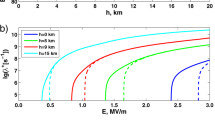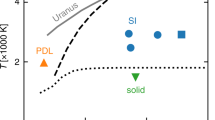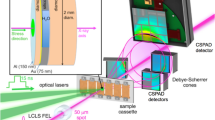Abstract
There is no general agreement on the nature of the mechanism which causes thunderstorms to become electrified1,2. Many scientists believe that charge is transferred when ice crystals collide with hailstones, and that subsequent gravitational separation results in field growth to breakdown magnitudes. Buser and Auf dermaur3 have proposed that the charging results from differences in the surface potential of ice. The measurements described here suggest that the surface potential of polycrystalline ice, such as would occur in a thunderstorm, is related simply to its past growth history. The sudden step in potential postulated by Buser and Aufdermaur as the ice surface changes from an evaporating to a growing state could not be detected. However, a natural hailstone grows by riming as it collects supercooled droplets, and these new measurements suggest that this effect results in much larger changes in surface potential.
This is a preview of subscription content, access via your institution
Access options
Subscribe to this journal
Receive 51 print issues and online access
$199.00 per year
only $3.90 per issue
Buy this article
- Purchase on Springer Link
- Instant access to full article PDF
Prices may be subject to local taxes which are calculated during checkout
Similar content being viewed by others
References
Moore, C. B. Q. Jl R. met. Soc. 102, 225–240 (1976).
Mason, B. J. Q. Jl R. met. Soc. 102, 219–224 (1976).
Buser, O. & Aufdermaur, A. N. Electrical Processes in Atmospheres (Steinkopff, Darmstadt, 1977).
Takahashi, T. J. atmos. Sci. 30, 1220–1224 (1973).
Takahashi, T. J. atmos. Sci. 27, 453–462 (1970).
Hobbs, P. V. Ice Physics, 170 (Clarendon, Oxford, 1974).
del Pennino, U., et al. Nuovo Cim. 24, 108–120 (1974).
Workman, E. J. & Reynolds, S. E. Phys. Rev. 78, 254–259 (1950).
Lange, E. Met. Z. 60, 154 (1943).
Kramer, C. Neth. Met. Inst. Med en Verhard A54 (1948).
Dye, J. E. & Hobbs, P. V. Nature 209, 464–466 (1966).
Pruppacher, H. R. & Klett, J. D. Microphysics of Clouds and Precipitation, 559 (Reidel, Dordrecht, 1978).
Author information
Authors and Affiliations
Rights and permissions
About this article
Cite this article
Caranti, J., Illingworth, A. Surface potentials of ice and thunderstorm charge separation. Nature 284, 44–46 (1980). https://doi.org/10.1038/284044a0
Received:
Accepted:
Issue Date:
DOI: https://doi.org/10.1038/284044a0
This article is cited by
-
Charge Separation Mechanisms in Clouds
Space Science Reviews (2008)
-
Light emission from colliding ice particles
Nature (1988)
-
Electrification of thundercloud by an entrainment mechanism
Meteorology and Atmospheric Physics (1988)
-
Possible role of transient electric fields in freezing-induced membrane destabilization
The Journal of Membrane Biology (1985)
Comments
By submitting a comment you agree to abide by our Terms and Community Guidelines. If you find something abusive or that does not comply with our terms or guidelines please flag it as inappropriate.



